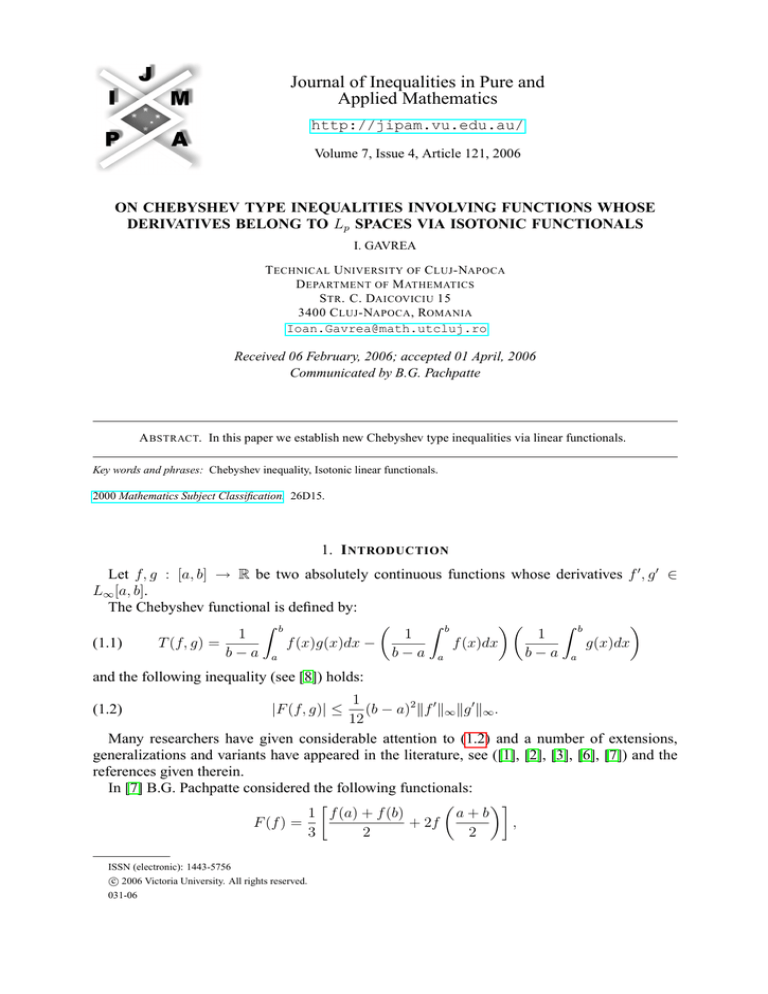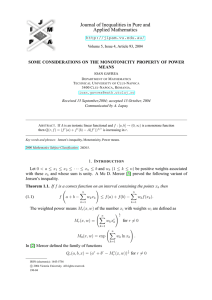
Journal of Inequalities in Pure and
Applied Mathematics
http://jipam.vu.edu.au/
Volume 7, Issue 4, Article 121, 2006
ON CHEBYSHEV TYPE INEQUALITIES INVOLVING FUNCTIONS WHOSE
DERIVATIVES BELONG TO Lp SPACES VIA ISOTONIC FUNCTIONALS
I. GAVREA
T ECHNICAL U NIVERSITY OF C LUJ -NAPOCA
D EPARTMENT OF M ATHEMATICS
S TR . C. DAICOVICIU 15
3400 C LUJ -NAPOCA , ROMANIA
Ioan.Gavrea@math.utcluj.ro
Received 06 February, 2006; accepted 01 April, 2006
Communicated by B.G. Pachpatte
A BSTRACT. In this paper we establish new Chebyshev type inequalities via linear functionals.
Key words and phrases: Chebyshev inequality, Isotonic linear functionals.
2000 Mathematics Subject Classification. 26D15.
1. I NTRODUCTION
Let f, g : [a, b] → R be two absolutely continuous functions whose derivatives f 0 , g 0 ∈
L∞ [a, b].
The Chebyshev functional is defined by:
Z b
Z b
Z b
1
1
1
(1.1)
T (f, g) =
f (x)g(x)dx −
f (x)dx
g(x)dx
b−a a
b−a a
b−a a
and the following inequality (see [8]) holds:
1
(b − a)2 kf 0 k∞ kg 0 k∞ .
12
Many researchers have given considerable attention to (1.2) and a number of extensions,
generalizations and variants have appeared in the literature, see ([1], [2], [3], [6], [7]) and the
references given therein.
In [7] B.G. Pachpatte considered the following functionals:
1 f (a) + f (b)
a+b
F (f ) =
+ 2f
,
3
2
2
(1.2)
|F (f, g)| ≤
ISSN (electronic): 1443-5756
c 2006 Victoria University. All rights reserved.
031-06
2
I. G AVREA
Z b
Z b
1
S(f, g) = F (f )F (g) −
F (f )
g(x)dx + F (g)
f (x)dx
b−a
a
a
Z b
Z b
1
1
+
f (x)dx
g(x)dx
b−a a
b−a a
and
1
H(f, g) =
b−a
Z
a
b
[F (f )g(x) + F (g)f (x)]dx
Z b
Z b
1
1
−2
f (x)dx
g(x)dx .
b−a a
b−a a
B.G. Pachpatte proved the following results:
Theorem 1.1. Let f, g : [a, b] → R be absolutely continuous functions whose derivatives
f 0 , g 0 ∈ Lp [a, b], p > 1. Then we have the inequalities
Z b
1
0
0
(1.3)
|T (f, g)| ≤
kf kp kg kp
[B(x)]2/q dx,
(b − a)3
a
1
|T (f, g)| ≤
2(b − a)2
(1.4)
Z
b
[|g(x)|kf 0 kp + |f (x)|kg 0 kp ][B(x)]1/q dx,
a
where
B(x) =
(1.5)
for x ∈ [a, b] and
1
p
+
1
q
(x − a)q+1 + (b − x)q+1
q+1
= 1.
Theorem 1.2. Let f, g : [a, b] → R be absolutely continuous functions whose derivatives
f 0 , g 0 ∈ Lp [a, b], p > 1. Then we have the inequalities:
|S(f, g)| ≤
(1.6)
1
M 2/q kf 0 kp kg 0 kp
2
(b − a)
and
1
|H(f, g)| ≤
M 1/q
2
(b − a)
(1.7)
where
M=
and
1
p
+
1
q
Z
b
[|g(x)|kf 0 kp + |f (x)|kg 0 kp ]dx,
a
(2q+1 + 1)(b − a)q+1
3(q + 1)6q
= 1.
The main purpose of the present note is to establish inequalities similar to the inequalities
(1.3) – (1.6) involving isotonic functionals.
2. S TATEMENT OF R ESULTS
Let I = [a, b] a fixed interval. For every t ∈ I we consider the function ut : [a, b] → R
defined by
(
0, x ∈ [a, t),
ut (x) =
1, x ∈ [t, b].
J. Inequal. Pure and Appl. Math., 7(4) Art. 121, 2006
http://jipam.vu.edu.au/
C HEBYSHEV T YPE I NEQUALITIES
3
Let L be a linear class of real valued functions f : I → R having the properties:
L1 :
f, g ∈ L ⇒ αf + βg ∈ L, for all α, β ∈ R
L2 :
ut ∈ L for all t ∈ [a, b].
An isotonic linear functional is a functional A : L → R having the following properties:
A1 :
A(αf + βg) = αA(f ) + βA(g) for f, g ∈ L, α, β ∈ R
A2 :
f ∈ L, f (t) ≥ 0 on I then A(f ) ≥ 0.
In what follows we denote by M the set of all isotonic functionals having the properties:
M1 :
A ∈ M then A(ut ) ∈ Lp (R) for all p ≥ 1
M2 :
A ∈ M then A(1) = 1.
Now, we state our main results as follows.
Theorem 2.1. Let f, g : [a, b] → R be absolutely continuous functions whose derivatives
f 0 , g 0 ∈ Lp [a, b], p > 1 and A, B, C isotonic functionals belong to M. Then we have the
following inequalities:
|C(f g) − C(f )B(g) − C(g)A(f ) + A(f )B(g)| ≤ C[K(A, B)]kf 0 kp kg 0 kp
(2.1)
and
|2C(f g) − C(f )B(g) − C(g)A(f )| ≤ C[Hf,g ],
(2.2)
where
Z
K(A, B)(x) =
b
1q Z b
1q
q
|ut (x) − A(ut )| dt
|ut (x) − B(ut )|
q
a
a
and
Z
Hf,g (x) = |g(x)|
b
1q
|ut (x) − A(ut )| dt kf 0 kp
q
a
Z
+ |f (x)|
b
1q
|ut (x) − B(ut )| dt kg 0 kp .
q
a
Theorem 2.2. Let f, g : [a, b] → R be absolutely continuous functions whose derivatives
f 0 , g 0 ∈ Lp [a, b], p > 1 and A, B two isotonic functionals belong to M. Then we have the
inequality:
|A(f )A(g) − A(f )C(g) − C(f )A(g) + C(f )C(g)| ≤ M 2/q kf 0 kp kg 0 kp ,
(2.3)
where
Z
M=
b
|A(ut ) − C(ut )|q dt
a
and
1
p
+
1
q
= 1.
J. Inequal. Pure and Appl. Math., 7(4) Art. 121, 2006
http://jipam.vu.edu.au/
4
I. G AVREA
3. P ROOF OF T HEOREM 2.1
From the identity:
Z
x
f (x) = f (a) +
f 0 (t)dt
a
and using the definition of the function ut we obtain the following equality
Z b
(3.1)
f (x) = f (a) +
ut (x)f 0 (t)dt.
a
Functional A being an isotonic functional from (3.1) we get
Z b
(3.2)
A(f ) = f (a) +
A(ut )f 0 (t)dt.
a
From (3.1) and (3.2) we obtain
Z
b
[ut (x) − A(ut )]f 0 (t)dt.
f (x) − A(f ) =
(3.3)
a
Similarly we obtain:
Z
g(x) − B(g) =
(3.4)
b
[ut (x) − B(ut )]g 0 (t)dt.
a
Multiplying the left sides and right sides of (3.3) and (3.4) we have:
(3.5)
f (x)g(x) − f (x)B(g) − g(x)A(f ) + A(f )B(g)
Z b
Z b
0
[ut (x) − B(ut )]g 0 (t)dt.
[ut (x) − A(ut )]f (t)dt
=
a
a
From (3.5) we obtain:
(3.6)
|f (x)g(x) − f (x)B(g) − g(x)A(f ) + A(f )B(g)|
Z b
Z b
0
|ut (x) − B(ut )||g 0 (t)|dt.
|ut (x) − A(ut )|f (t)dt
≤
a
a
Using Hölder’s integral inequality from (3.6) we get:
(3.7) |f (x)g(x) − f (x)B(g) − g(x)A(f ) + A(f )B(g)|
Z b
1q Z b
1q
q
q
≤
|ut (x) − A(ut )| dt
|ut (x) − B(ut )|
kf 0 kp kg 0 kp .
a
a
From (3.7) applying the functional C and using the fact that C is an isotonic linear functional
we obtain inequality (2.1).
Multiplying both sides of (3.3) and (3.4) by g(x) and f (x) respectively and adding the resulting identities we get:
(3.8) 2f (x)g(x) − g(x)A(f ) − f (x)B(g)
Z b
Z b
0
=
g(x)[ut (x) − A(ut )]f (t)dt +
f (x)[ut (x) − B(ut )]g 0 (t)dt.
a
J. Inequal. Pure and Appl. Math., 7(4) Art. 121, 2006
a
http://jipam.vu.edu.au/
C HEBYSHEV T YPE I NEQUALITIES
5
From (3.8), using the properties of modulus, Hölder’s integral inequality we have:
(3.9) |2f (x)g(x) − g(x)A(f ) − f (x)B(g)|
Z b
1q
q
≤ |g(x)|
|ut (x) − A(ut )| dt kf 0 kp
a
Z
+ |f (x)|
b
1q
|ut (x) − B(ut )|q dt kg 0 kp
a
or
(3.10)
|2f (x)g(x) − g(x)A(f ) − f (x)B(g)| ≤ Hf,g (x).
The functional C being an isotonic linear functional we have:
(3.11)
C(|2f (x)g(x) − g(x)A(f ) − f (x)B(g)|) ≥ |2C(f g) − C(g)A(f ) − C(f )B(g)|.
From (3.10) applying the functional C and using (3.11) we obtain inequality (2.2).
The proof of Theorem 2.1 is complete.
4. P ROOF OF T HEOREM 2.2
From (3.1) we have:
b
Z
(4.1)
[ut (x) − ut (y)]f 0 (t)dt
f (x) − f (y) =
a
and
b
Z
(4.2)
[ut (x) − ut (y)]g 0 (t)dt.
g(x) − g(y) =
a
Applying the functionals A and C in (4.1) and (4.2) we obtain
Z b
(4.3)
A(f ) − C(f ) =
[A(ut ) − C(ut )]f 0 (t)dt
a
and
Z
(4.4)
A(g) − C(g) =
b
[A(ut ) − C(ut )]g 0 (t)dt.
a
Multiplying the left sides and right sides of (4.3) and (4.4) we have
(4.5)
A(f )A(g) − A(f )C(g) − A(g)C(f ) + C(f )C(g)
Z b
Z b
0
=
[A(ut ) − C(ut )]f (t)dt
[A(ut ) − C(ut )]g 0 (t)dt.
a
a
Using Hölder’s integral inequality from (4.5) we obtain
|A(f )A(g) − A(f )C(g) − A(g)C(f ) + C(f )C(g)|
Z b
2q
q
≤
|A(ut ) − C(ut )| dt kf 0 kp kg 0 kp .
a
The last inequality proves the theorem.
J. Inequal. Pure and Appl. Math., 7(4) Art. 121, 2006
http://jipam.vu.edu.au/
6
I. G AVREA
5. R EMARKS
a) For
Z b
1
A(f ) = B(f ) = C(f ) =
f (x)dx
b−a a
then from Theorem 2.1 we obtain the results from Theorem 1.1.
b) Inequality (1.6) is a particular case of the inequality (2.3) when A = F ,
Z b
1
f (x)dx.
C(f ) =
b−a a
R EFERENCES
[1] S.S. DRAGOMIR, On Simpson’s quadrature formula for differentiable mappings whose derivatives
belong to Lp spaces and applications, J. KSIAM, 2(2) (1998), 57–65.
[2] S.S. DRAGOMIR AND S. WANG, A new inequality of Ostrowski type in Lp norm, Indian J. Math.,
40(3) (1998), 299–304.
[3] H.P. HEINIG AND L. MALIGRANDA, Chebyshev inequality in function spaces, Real Analysis and
Exchange, 17 (1991-92), 211–217.
[4] D.S. MITRINOVIĆ, J.E. PEČARIĆ AND A.M. FINK, Classical and New Inequalities in Analysis,
Kluwer Academic Publishers, Dordrecht, 1993.
[5] D.S. MITRINOVIĆ, J.E. PEČARIĆ AND A.M. FINK, Inequalities Involving Functions and Their
Integrals and Derivatives, Kluwer Academic Publishers, Dordrecht, 1994.
[6] B.G. PACHPATTE, On Ostrowski-Grüss-Chebyshev type inequalities for functions whose modulus
of derivatives are convex, J. Inequal. Pure and Appl. Math., 6(4) (2005), Art. 128. [ONLINE: http:
//jipam.vu.edu.au/article.php?sid=602].
[7] B.G. PACHPATTE, On Chebyshev type inequalities involving functions whose derivatives belong
to Lp spaces, J. Inequal. Pure and Appl. Math., 7(2) (2006), Art. 58. [ONLINE: http://jipam.
vu.edu.au/article.php?sid=675].
[8] J.E. PEČARIĆ, F. PORCHAN AND Y. TANG, Convex Functions, Partial Orderings and Statistical
Applications, Academic Press, San Diego, 1992.
J. Inequal. Pure and Appl. Math., 7(4) Art. 121, 2006
http://jipam.vu.edu.au/






